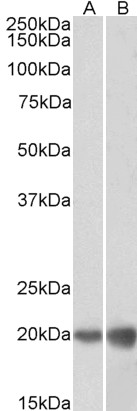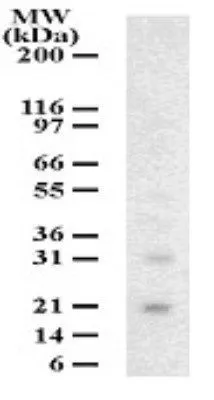DUT antibody [HL1210]
GTX636527
ApplicationsImmunoFluorescence, Western Blot, ImmunoCytoChemistry, ImmunoHistoChemistry, ImmunoHistoChemistry Paraffin
Product group Antibodies
TargetDUT
Overview
- SupplierGeneTex
- Product NameDUT antibody [HL1210]
- Delivery Days Customer9
- Application Supplier NoteIHC-P: 1:100-1:1000. *Optimal dilutions/concentrations should be determined by the researcher.Not tested in other applications.
- ApplicationsImmunoFluorescence, Western Blot, ImmunoCytoChemistry, ImmunoHistoChemistry, ImmunoHistoChemistry Paraffin
- CertificationResearch Use Only
- ClonalityMonoclonal
- Clone IDHL1210
- Concentration1 mg/ml
- ConjugateUnconjugated
- Gene ID1854
- Target nameDUT
- Target descriptiondeoxyuridine triphosphatase
- Target synonymsBMFDMS, dUTPase, deoxyuridine 5'-triphosphate nucleotidohydrolase, mitochondrial, dUTP diphosphatase, dUTP nucleotidohydrolase, dUTP pyrophosphatase
- HostRabbit
- IsotypeIgG
- Protein IDP33316
- Protein NameDeoxyuridine 5'-triphosphate nucleotidohydrolase, mitochondrial
- Scientific DescriptionThis gene encodes an essential enzyme of nucleotide metabolism. The encoded protein forms a ubiquitous, homotetrameric enzyme that hydrolyzes dUTP to dUMP and pyrophosphate. This reaction serves two cellular purposes: providing a precursor (dUMP) for the synthesis of thymine nucleotides needed for DNA replication, and limiting intracellular pools of dUTP. Elevated levels of dUTP lead to increased incorporation of uracil into DNA, which induces extensive excision repair mediated by uracil glycosylase. This repair process, resulting in the removal and reincorporation of dUTP, is self-defeating and leads to DNA fragmentation and cell death. Alternative splicing of this gene leads to different isoforms that localize to either the mitochondrion or nucleus. A related pseudogene is located on chromosome 19. [provided by RefSeq, Jul 2008]
- Storage Instruction-20°C or -80°C,2°C to 8°C
- UNSPSC12352203







